Stress-Strain Behaviour of Fibre Reinforced Concrete with Different Proportions of Polypropylene and Steel Fibre
VerifiedAdded on 2023/06/16
|14
|1357
|50
AI Summary
This study aims to investigate the stress-strain behaviour, compressive strength, workability, and find the best combination of materials to be used for hybrid fiber reinforced concrete. The best composition of hybrid fiber is 50% polypropylene with 50% steel fiber. Addition of 1.5% of hybrid fiber containing 50% polypropylene and 50% steel fiber improves the axial properties of M20 grade concrete. Addition of hybrid fibers improves the compression strength, flexural tensile strength and split tensile strength.
Contribute Materials
Your contribution can guide someone’s learning journey. Share your
documents today.

STRESS-STRAIN BEHAVIOUR OF FIBRE
REINFORCED CONCRETE WITH
DIFFERENT
PROPORTIONS OF POLYPROPYLENE
AND STEEL FIBRE
REINFORCED CONCRETE WITH
DIFFERENT
PROPORTIONS OF POLYPROPYLENE
AND STEEL FIBRE
Secure Best Marks with AI Grader
Need help grading? Try our AI Grader for instant feedback on your assignments.
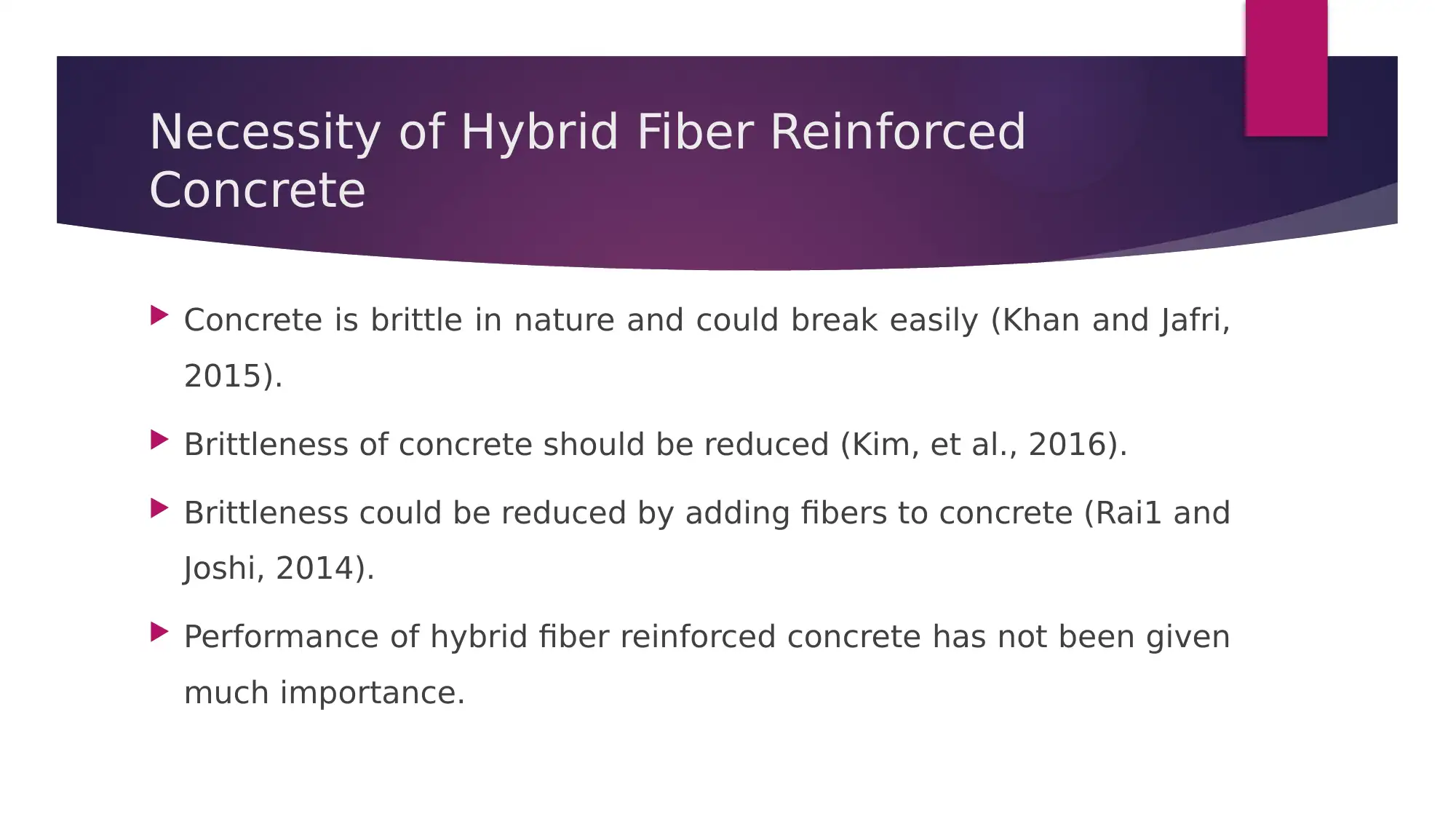
Necessity of Hybrid Fiber Reinforced
Concrete
Concrete is brittle in nature and could break easily (Khan and Jafri,
2015).
Brittleness of concrete should be reduced (Kim, et al., 2016).
Brittleness could be reduced by adding fibers to concrete (Rai1 and
Joshi, 2014).
Performance of hybrid fiber reinforced concrete has not been given
much importance.
Concrete
Concrete is brittle in nature and could break easily (Khan and Jafri,
2015).
Brittleness of concrete should be reduced (Kim, et al., 2016).
Brittleness could be reduced by adding fibers to concrete (Rai1 and
Joshi, 2014).
Performance of hybrid fiber reinforced concrete has not been given
much importance.
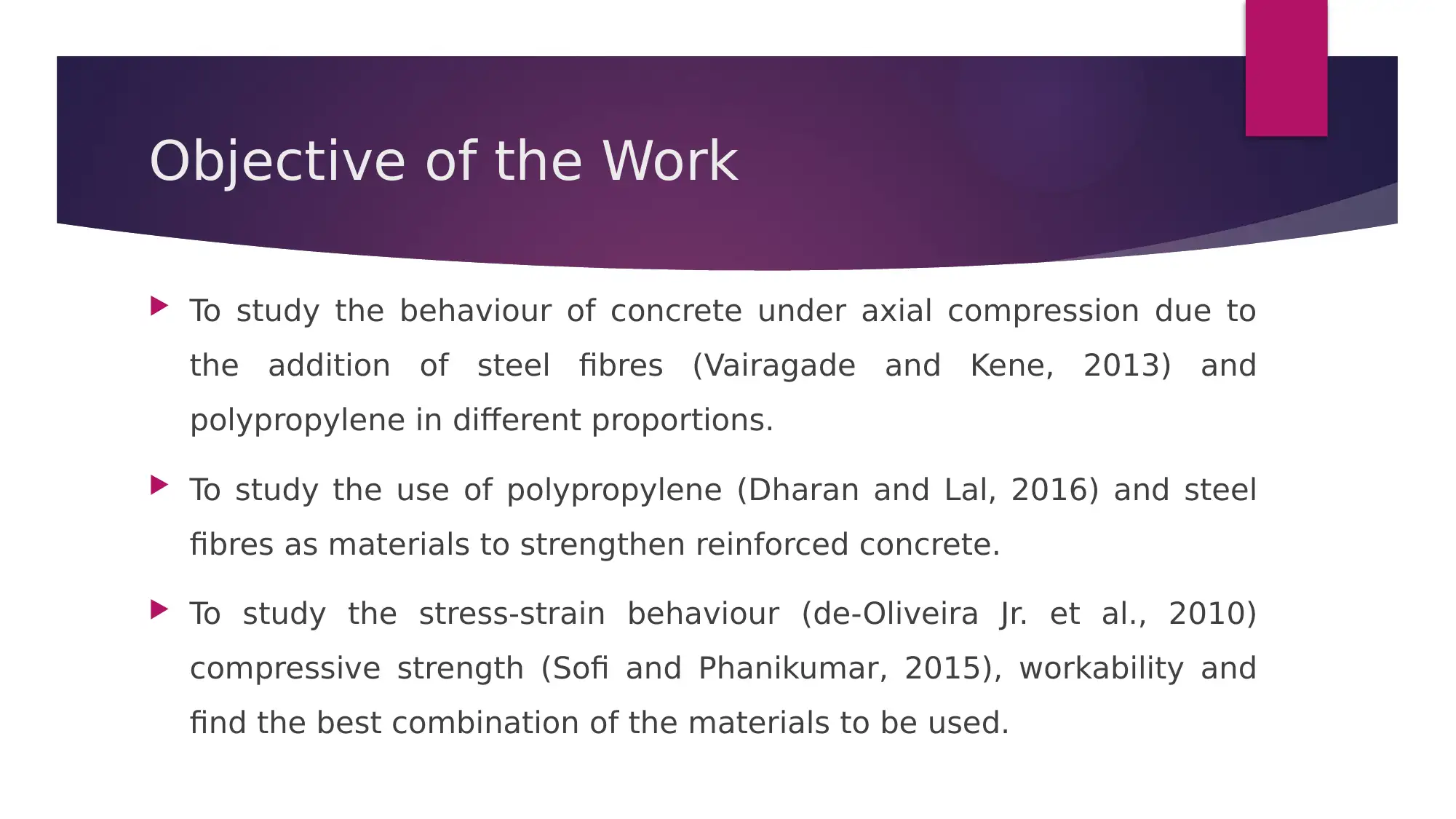
Objective of the Work
To study the behaviour of concrete under axial compression due to
the addition of steel fibres (Vairagade and Kene, 2013) and
polypropylene in different proportions.
To study the use of polypropylene (Dharan and Lal, 2016) and steel
fibres as materials to strengthen reinforced concrete.
To study the stress-strain behaviour (de-Oliveira Jr. et al., 2010)
compressive strength (Sofi and Phanikumar, 2015), workability and
find the best combination of the materials to be used.
To study the behaviour of concrete under axial compression due to
the addition of steel fibres (Vairagade and Kene, 2013) and
polypropylene in different proportions.
To study the use of polypropylene (Dharan and Lal, 2016) and steel
fibres as materials to strengthen reinforced concrete.
To study the stress-strain behaviour (de-Oliveira Jr. et al., 2010)
compressive strength (Sofi and Phanikumar, 2015), workability and
find the best combination of the materials to be used.

Methodology
Mix M20 grade concrete (Goyal and Vikram, 2017) with different
percentages (0%, 0.5%, 1.0%, 1.5%, and 2.0%) of the hybrid fibers.
The ratio of polypropylene and steel fibre would be varied as follows
100:0, 75:25, 50:50 so as to obtain different proportions of hybrid fibres.
Each proportion of hybrid fibres are cast into 2 cylinders and 2 cubes.
They are then tested using 200 Tons capacity CTM.
Aspect ratio of steel fibre used is 55.
Mix M20 grade concrete (Goyal and Vikram, 2017) with different
percentages (0%, 0.5%, 1.0%, 1.5%, and 2.0%) of the hybrid fibers.
The ratio of polypropylene and steel fibre would be varied as follows
100:0, 75:25, 50:50 so as to obtain different proportions of hybrid fibres.
Each proportion of hybrid fibres are cast into 2 cylinders and 2 cubes.
They are then tested using 200 Tons capacity CTM.
Aspect ratio of steel fibre used is 55.
Secure Best Marks with AI Grader
Need help grading? Try our AI Grader for instant feedback on your assignments.
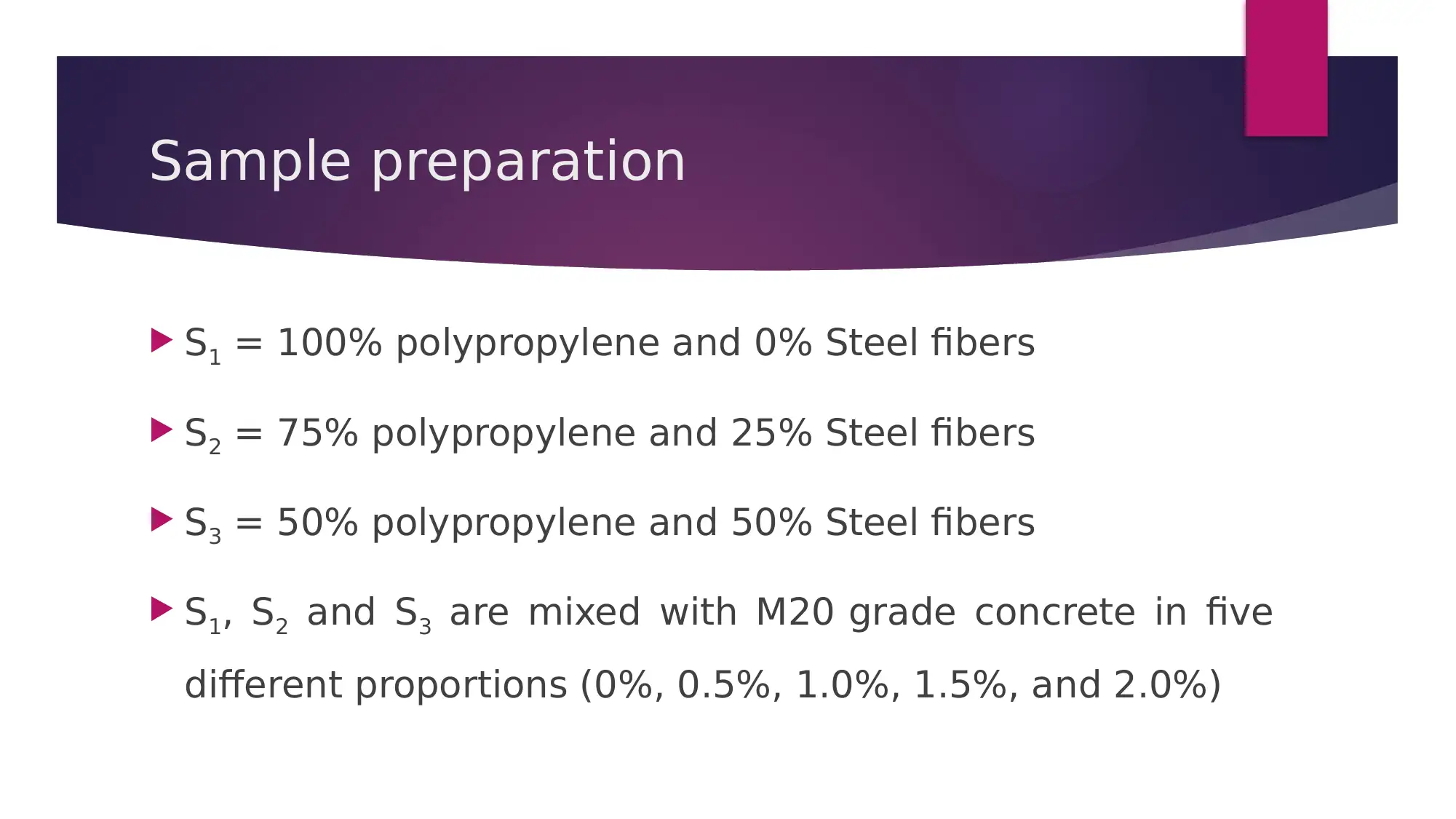
Sample preparation
S1 = 100% polypropylene and 0% Steel fibers
S2 = 75% polypropylene and 25% Steel fibers
S3 = 50% polypropylene and 50% Steel fibers
S1, S2 and S3 are mixed with M20 grade concrete in five
different proportions (0%, 0.5%, 1.0%, 1.5%, and 2.0%)
S1 = 100% polypropylene and 0% Steel fibers
S2 = 75% polypropylene and 25% Steel fibers
S3 = 50% polypropylene and 50% Steel fibers
S1, S2 and S3 are mixed with M20 grade concrete in five
different proportions (0%, 0.5%, 1.0%, 1.5%, and 2.0%)

Results
Samples Compressive
Strength
Flexural
Tensile
Strength
Split Tensile
Strength
Compaction
Factor
M20 20 N/mm2 4 N/mm2 2.5 N/mm2 0.95
M20+ 0.5%S1 22.4 N/mm2 5.2 N/mm2 3.4 N/mm2 0.93
M20 + 1.0%S1 23.6 N/mm2 5.8 N/mm2 3.9 N/mm2 0.92
M20 + 1.5%S1 25.2 N/mm2 7.9 N/mm2 5.2 N/mm2 0.90
M20 + 2.0%S1 24.5 N/mm2 7.1 N/mm2 4.3 N/mm2 0.88
M20 + 0.5%S2 23.7 N/mm2 5.6 N/mm2 3.7 N/mm2 0.94
M20 + 1.0%S2 25.3 N/mm2 6.2 N/mm2 4.3 N/mm2 0.93
M20 + 1.5%S2 27.9 N/mm2 8.3 N/mm2 5.7 N/mm2 0.91
M20 + 2.0%S2 27.6 N/mm2 7.6 N/mm2 4.6 N/mm2 0.90
M20 + 0.5%S3 23.9 N/mm2 5.8 N/mm2 4.2 N/mm2 0.95
M20 + 1.0%S3 26.2 N/mm2 6.6 N/mm2 4.7 N/mm2 0.95
M20 + 1.5%S3 30.5 N/mm2 8.7 N/mm2 6.2 N/mm2 0.96
Samples Compressive
Strength
Flexural
Tensile
Strength
Split Tensile
Strength
Compaction
Factor
M20 20 N/mm2 4 N/mm2 2.5 N/mm2 0.95
M20+ 0.5%S1 22.4 N/mm2 5.2 N/mm2 3.4 N/mm2 0.93
M20 + 1.0%S1 23.6 N/mm2 5.8 N/mm2 3.9 N/mm2 0.92
M20 + 1.5%S1 25.2 N/mm2 7.9 N/mm2 5.2 N/mm2 0.90
M20 + 2.0%S1 24.5 N/mm2 7.1 N/mm2 4.3 N/mm2 0.88
M20 + 0.5%S2 23.7 N/mm2 5.6 N/mm2 3.7 N/mm2 0.94
M20 + 1.0%S2 25.3 N/mm2 6.2 N/mm2 4.3 N/mm2 0.93
M20 + 1.5%S2 27.9 N/mm2 8.3 N/mm2 5.7 N/mm2 0.91
M20 + 2.0%S2 27.6 N/mm2 7.6 N/mm2 4.6 N/mm2 0.90
M20 + 0.5%S3 23.9 N/mm2 5.8 N/mm2 4.2 N/mm2 0.95
M20 + 1.0%S3 26.2 N/mm2 6.6 N/mm2 4.7 N/mm2 0.95
M20 + 1.5%S3 30.5 N/mm2 8.7 N/mm2 6.2 N/mm2 0.96

Stress – Strain Relationship
Paraphrase This Document
Need a fresh take? Get an instant paraphrase of this document with our AI Paraphraser

Discussions
The results shown in the table indicates that the highest compressive
strength is obtained when M20 grade concrete is mixed with 1.5% of
hybrid fibers made up of 50% polypropylene and 50% steel fibers (Yet,
Hamid and Kasmuri, 2012).
Both flexural and split tensile strength are also higher for the same
sample (i.e., the sample with 50% polypropylene and 50% steel fibers)
and it occurs when 1.5% of the sample is mixed with M20 grade
concrete.
The results shown in the table indicates that the highest compressive
strength is obtained when M20 grade concrete is mixed with 1.5% of
hybrid fibers made up of 50% polypropylene and 50% steel fibers (Yet,
Hamid and Kasmuri, 2012).
Both flexural and split tensile strength are also higher for the same
sample (i.e., the sample with 50% polypropylene and 50% steel fibers)
and it occurs when 1.5% of the sample is mixed with M20 grade
concrete.

Discussions Continued
Compaction factor which indicates the workability of concrete is
also highest for the sample with 1.5% hybrid fiber and a percentage
of 50% steel fiber (Song and Yin, 2016) and 50% polypropylene.
It could be seen from the graph that the stress-strain relationship is
also improved when 1.5% of hybrid fiber with a mixture of 50%
steel fiber and 50% polypropylene is used.
Compaction factor which indicates the workability of concrete is
also highest for the sample with 1.5% hybrid fiber and a percentage
of 50% steel fiber (Song and Yin, 2016) and 50% polypropylene.
It could be seen from the graph that the stress-strain relationship is
also improved when 1.5% of hybrid fiber with a mixture of 50%
steel fiber and 50% polypropylene is used.
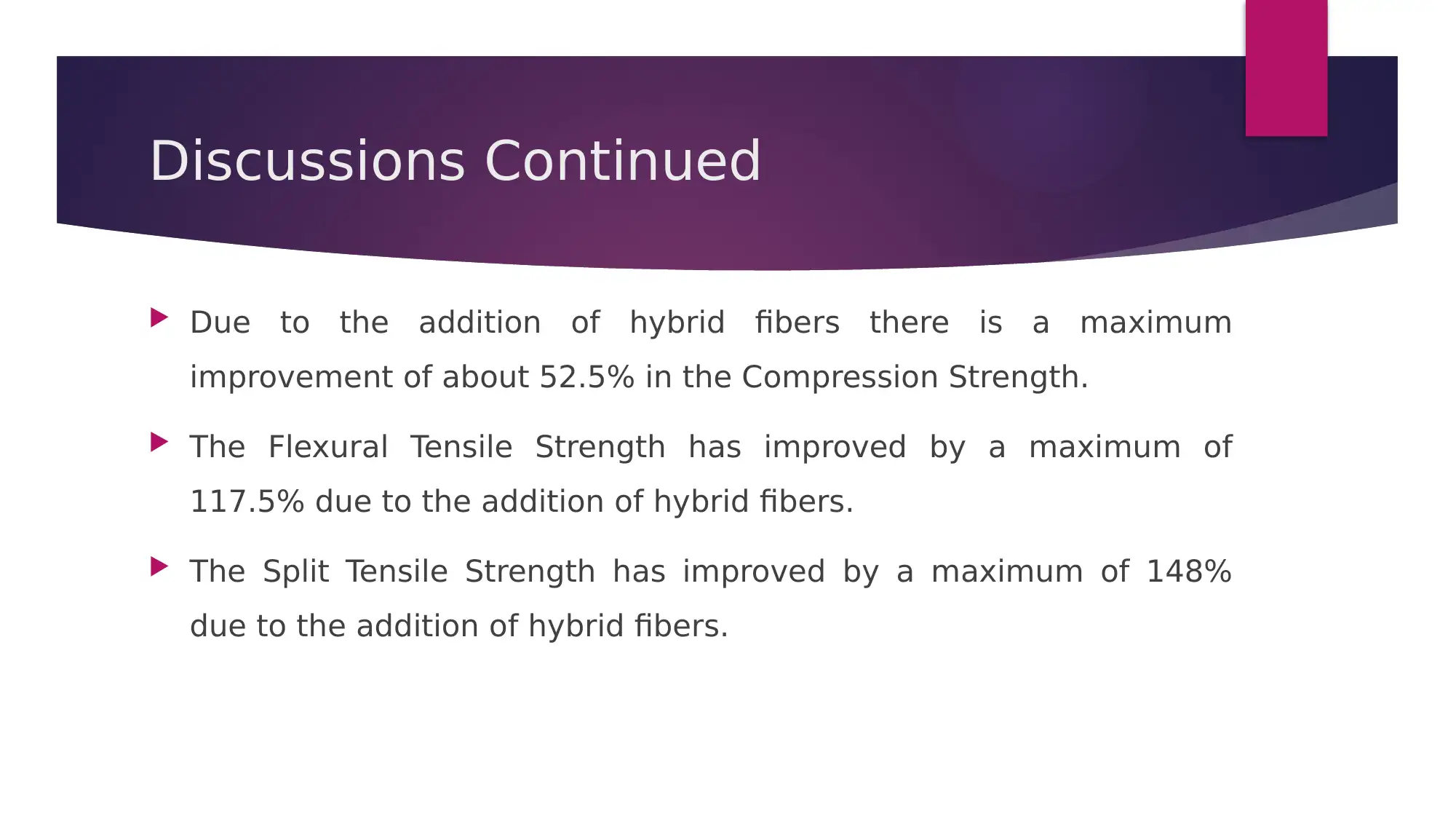
Discussions Continued
Due to the addition of hybrid fibers there is a maximum
improvement of about 52.5% in the Compression Strength.
The Flexural Tensile Strength has improved by a maximum of
117.5% due to the addition of hybrid fibers.
The Split Tensile Strength has improved by a maximum of 148%
due to the addition of hybrid fibers.
Due to the addition of hybrid fibers there is a maximum
improvement of about 52.5% in the Compression Strength.
The Flexural Tensile Strength has improved by a maximum of
117.5% due to the addition of hybrid fibers.
The Split Tensile Strength has improved by a maximum of 148%
due to the addition of hybrid fibers.
Secure Best Marks with AI Grader
Need help grading? Try our AI Grader for instant feedback on your assignments.

Discussions Continued
The workability of concrete decreases due to the addition of
polypropylene but improves due to the addition of steel fibers
(Razzak, and Ali, 2011).
Addition of hybrid fibers improves the stress-strain characteristics
(Rizzuti and Bencardino, 2014). of M20 grade concrete.
The workability of concrete decreases due to the addition of
polypropylene but improves due to the addition of steel fibers
(Razzak, and Ali, 2011).
Addition of hybrid fibers improves the stress-strain characteristics
(Rizzuti and Bencardino, 2014). of M20 grade concrete.
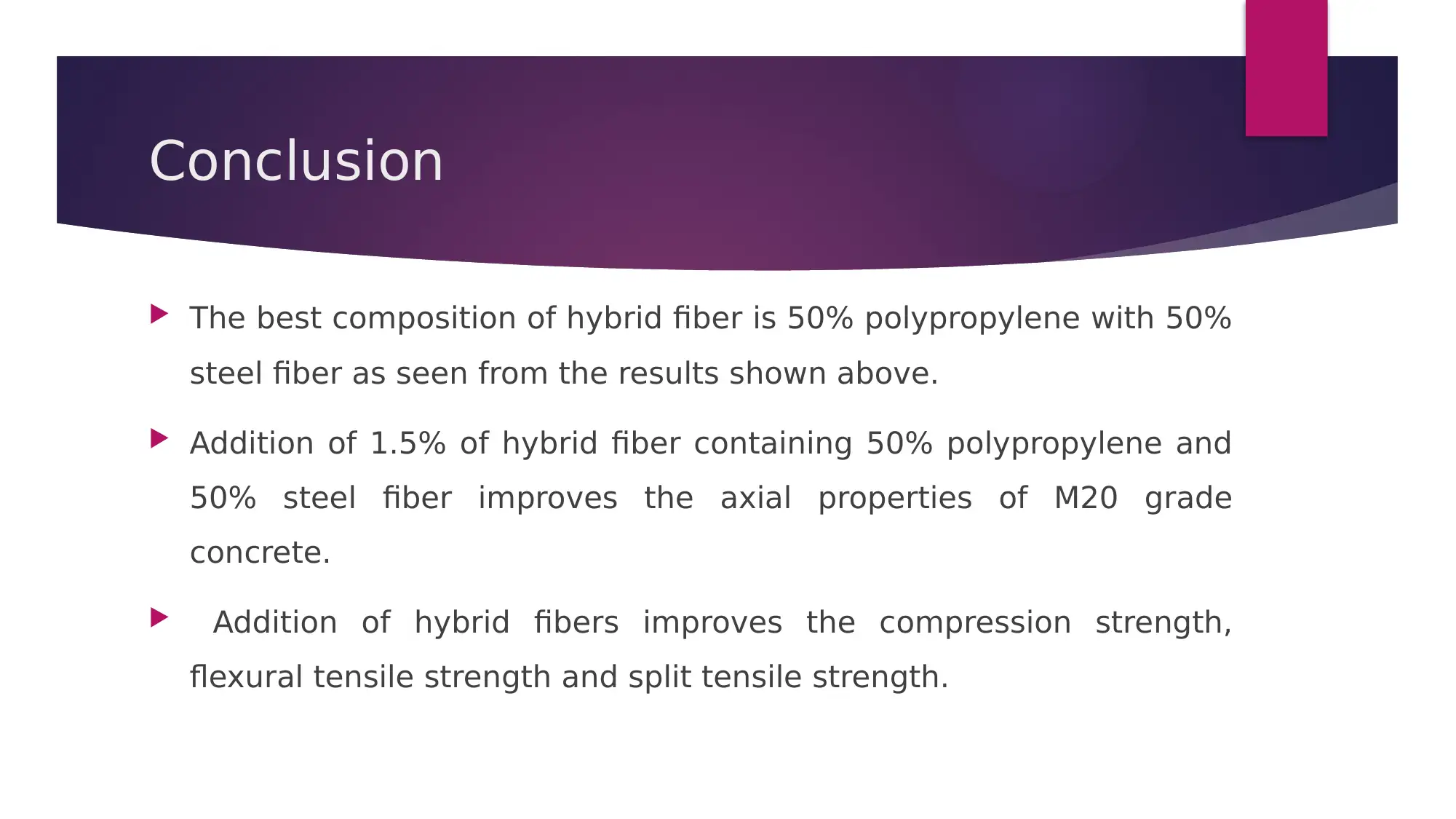
Conclusion
The best composition of hybrid fiber is 50% polypropylene with 50%
steel fiber as seen from the results shown above.
Addition of 1.5% of hybrid fiber containing 50% polypropylene and
50% steel fiber improves the axial properties of M20 grade
concrete.
Addition of hybrid fibers improves the compression strength,
flexural tensile strength and split tensile strength.
The best composition of hybrid fiber is 50% polypropylene with 50%
steel fiber as seen from the results shown above.
Addition of 1.5% of hybrid fiber containing 50% polypropylene and
50% steel fiber improves the axial properties of M20 grade
concrete.
Addition of hybrid fibers improves the compression strength,
flexural tensile strength and split tensile strength.
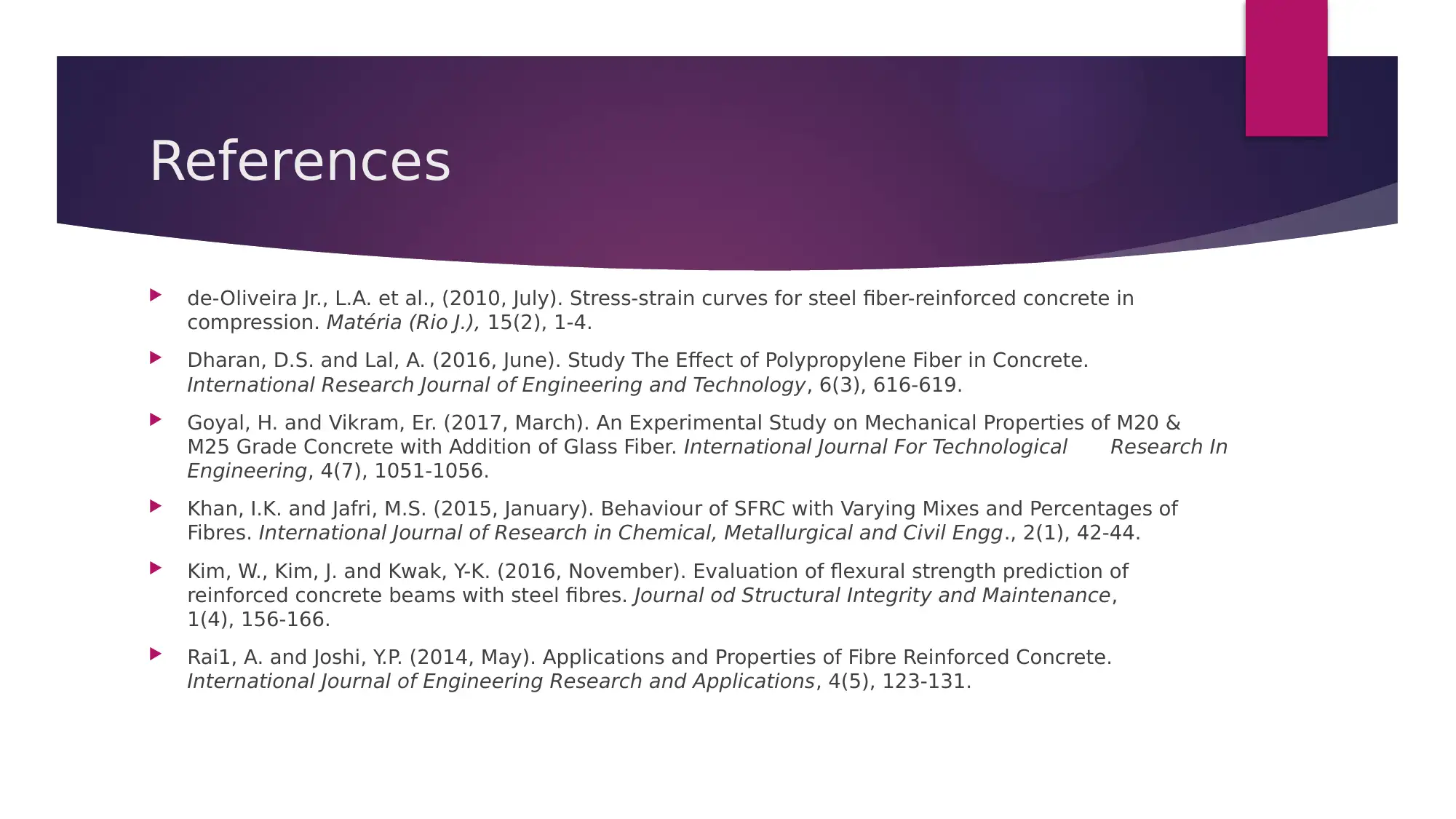
References
de-Oliveira Jr., L.A. et al., (2010, July). Stress-strain curves for steel fiber-reinforced concrete in
compression. Matéria (Rio J.), 15(2), 1-4.
Dharan, D.S. and Lal, A. (2016, June). Study The Effect of Polypropylene Fiber in Concrete.
International Research Journal of Engineering and Technology, 6(3), 616-619.
Goyal, H. and Vikram, Er. (2017, March). An Experimental Study on Mechanical Properties of M20 &
M25 Grade Concrete with Addition of Glass Fiber. International Journal For Technological Research In
Engineering, 4(7), 1051-1056.
Khan, I.K. and Jafri, M.S. (2015, January). Behaviour of SFRC with Varying Mixes and Percentages of
Fibres. International Journal of Research in Chemical, Metallurgical and Civil Engg., 2(1), 42-44.
Kim, W., Kim, J. and Kwak, Y-K. (2016, November). Evaluation of flexural strength prediction of
reinforced concrete beams with steel fibres. Journal od Structural Integrity and Maintenance,
1(4), 156-166.
Rai1, A. and Joshi, Y.P. (2014, May). Applications and Properties of Fibre Reinforced Concrete.
International Journal of Engineering Research and Applications, 4(5), 123-131.
de-Oliveira Jr., L.A. et al., (2010, July). Stress-strain curves for steel fiber-reinforced concrete in
compression. Matéria (Rio J.), 15(2), 1-4.
Dharan, D.S. and Lal, A. (2016, June). Study The Effect of Polypropylene Fiber in Concrete.
International Research Journal of Engineering and Technology, 6(3), 616-619.
Goyal, H. and Vikram, Er. (2017, March). An Experimental Study on Mechanical Properties of M20 &
M25 Grade Concrete with Addition of Glass Fiber. International Journal For Technological Research In
Engineering, 4(7), 1051-1056.
Khan, I.K. and Jafri, M.S. (2015, January). Behaviour of SFRC with Varying Mixes and Percentages of
Fibres. International Journal of Research in Chemical, Metallurgical and Civil Engg., 2(1), 42-44.
Kim, W., Kim, J. and Kwak, Y-K. (2016, November). Evaluation of flexural strength prediction of
reinforced concrete beams with steel fibres. Journal od Structural Integrity and Maintenance,
1(4), 156-166.
Rai1, A. and Joshi, Y.P. (2014, May). Applications and Properties of Fibre Reinforced Concrete.
International Journal of Engineering Research and Applications, 4(5), 123-131.
Paraphrase This Document
Need a fresh take? Get an instant paraphrase of this document with our AI Paraphraser

References Continued
Razzak, A.A.A. and Ali, A.A.M. (2011, June). Modelling and numerical simulation of high strength
fibre reinforced concrete corbels. Applied Mathematical Modelling, 35(6), 2901-2915.
Rizzuti, L. and Bencardino, F. (2014, October). Effects of Fibre Volume Fraction on the Compressive
and Flexural Experimental Behaviour of SFRC. Contemporary Engineering Sciences, 7(8),
379- 390.
Sofi, A. and Phanikumar, B.R. (2015, December). An experimental investigation on flexural
behaviour of fibre-reinforced pond ash-modified concrete. Ain Shams Engineering Journal,
6(4), 1133- 1142.
Song, W. and Yin, J. (2016, August). Hybrid Effect Evaluation of Steel Fiber and Carbon Fiber on the
Performance of the Fiber Reinforced Concrete. Materials, 9(8), 1-8.
Vairagade, V.S. and Kene, K.S. (2013). Strength of Normal Concrete using Metallic and Synthetic
Fibres. Procedia Engineering, 51, 132-140.
Yet, T.C., Hamid, R. and Kasmuri, M. (2012, October). Dynamic Stress-Strain Behaviour of Steel
Fiber Reinforced High-Performance Concrete with Fly Ash. Advances in Civil Engineering.
Retrieved from http://dx.doi.org/10.1155/2012/907431 .
Razzak, A.A.A. and Ali, A.A.M. (2011, June). Modelling and numerical simulation of high strength
fibre reinforced concrete corbels. Applied Mathematical Modelling, 35(6), 2901-2915.
Rizzuti, L. and Bencardino, F. (2014, October). Effects of Fibre Volume Fraction on the Compressive
and Flexural Experimental Behaviour of SFRC. Contemporary Engineering Sciences, 7(8),
379- 390.
Sofi, A. and Phanikumar, B.R. (2015, December). An experimental investigation on flexural
behaviour of fibre-reinforced pond ash-modified concrete. Ain Shams Engineering Journal,
6(4), 1133- 1142.
Song, W. and Yin, J. (2016, August). Hybrid Effect Evaluation of Steel Fiber and Carbon Fiber on the
Performance of the Fiber Reinforced Concrete. Materials, 9(8), 1-8.
Vairagade, V.S. and Kene, K.S. (2013). Strength of Normal Concrete using Metallic and Synthetic
Fibres. Procedia Engineering, 51, 132-140.
Yet, T.C., Hamid, R. and Kasmuri, M. (2012, October). Dynamic Stress-Strain Behaviour of Steel
Fiber Reinforced High-Performance Concrete with Fly Ash. Advances in Civil Engineering.
Retrieved from http://dx.doi.org/10.1155/2012/907431 .
1 out of 14
Your All-in-One AI-Powered Toolkit for Academic Success.
+13062052269
info@desklib.com
Available 24*7 on WhatsApp / Email
![[object Object]](/_next/static/media/star-bottom.7253800d.svg)
Unlock your academic potential
© 2024 | Zucol Services PVT LTD | All rights reserved.
